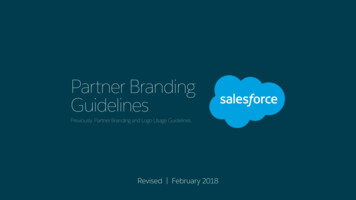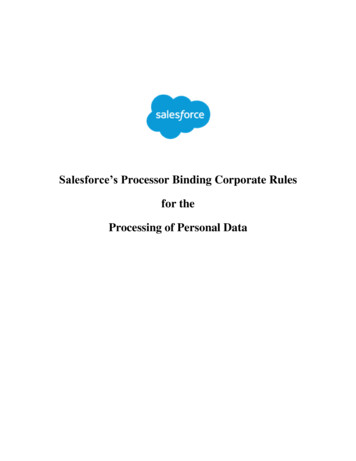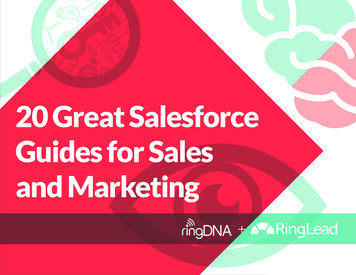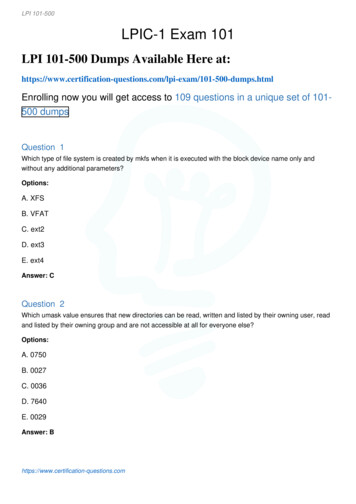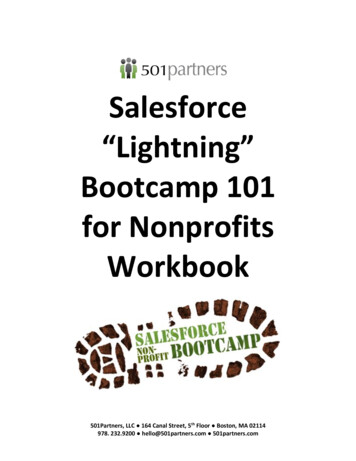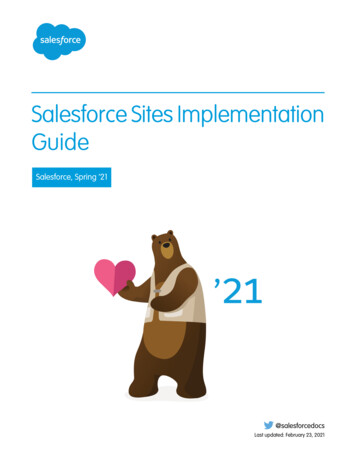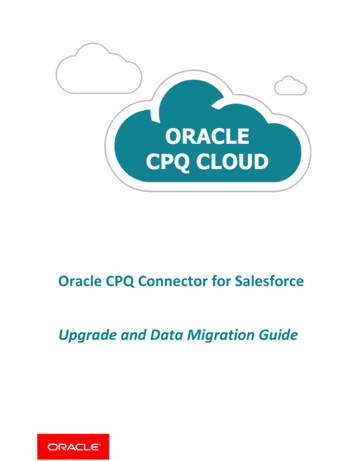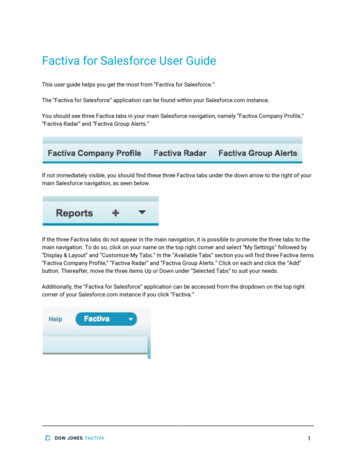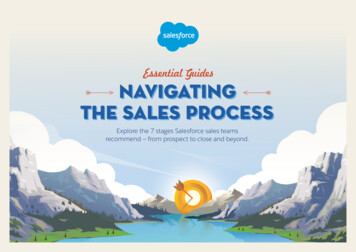
Transcription
navigatingTHE SALES PROCESSExplore the 7 stages Salesforce sales teamsrecommend — from prospect to close and beyond.
YOURJOURNEYSTARTSHERESTAGE 1STAGE 5Contacting LeadsStructuring the DealBefore you start your sales journey, prepare towalk a mile in your prospect’s shoes.Be patient, hold to your bottom line, and talkabout value before numbers. Only draw up acontract when you’re ready.STAGE 2Qualifying LeadsQualify leads with a customer-centricapproach—listen and learn along the trail.STAGE 6Finalising the ProposalAddress last-minute hesitations before thefinal stretch. If there are objections, rely onrelationships you’ve already built.STAGE 3Providing ValuePack the right gear for the sales pitch, startingwith vision, data, and value.STAGE 4Handling ObjectionsMove prospects along the trail by usingobjections as opportunities to learn moreabout their needs.STAGE 7Closing and Keeping CommitmentsReach the summit with your pact intact—utilise the right teams and technology to keepyour new customers happy and on track.
Stage 1Contacting Leads5 TIPS FOR EFFECTIVECUSTOMER ACQUISITIONyour key tips1 Engage Sales Prospects2 Control Costs with a Targeted Approach3 Educate Your Customers4 Network and Build PartnershipsOnce you’ve gathered leads, you’re ready to startcontacting them, right?Not quite! That would be like sending yourexpedition into the wilderness without a map.Ensure that you and your leads are on a journeytogether that is about more than just a sale.5 Build on Your Foundation With ReferralsWe’ll go into more detail on these tips in the nextfew pages.
STAGE 1STAGE 2STAGE 31 ENGAGE SALES PROSPECTSPrepare the trail for your potential customers by:Interviewing Your Existing CustomersWhat are their pain points? What do they value mostabout your products? What can talking to them tell youabout your potential customers?Building a Welcoming PresenceThink about how your brand can address customer painpoints and offer them something of value. Make yourdigital presence user-friendly and customer-focused.Interacting with Customers and Prospects on’t just offer a one-way message: ask for feedback,Doffer individualised advice, and provide a forum forcustomers to interact with you and with each other.Sales AI can come in handy here!STAGE 4STAGE 5STAGE 6STAGE 72 CONTROL COSTS WITH ATARGETED APPROACHThe path to turning sales leads into customers canbe a winding one, especially for small businesses.Pack light and get to know your company’s targetaudience beyond just their age range, gender,and location.PACK YOURRUCKSACKCAREFULLY.Questions you should be able to answer aboutyour target audience: How do they spend their money? What are they passionate about? What is their idea of fun? What are their values? Where do they spend time online? How do they prefer to be contacted?Whether you contact them by email or through socialmedia, don’t just focus on promoting your company.Offer them relevant, engaging content. Your well-formedbrand and community will take it from there.Content-basedmarketing costs62%less than outboundmarketing, whilegenerating threetimes more leads.1
STAGE 1STAGE 2STAGE 3STAGE 4STAGE 5STAGE 6STAGE 73 EDUCATE YOUR CUSTOMERSEducating your customers builds trustDon’t run up the mountain without building the trust ofyour party. They could wander off the trail and end upbumping into other brands that take better care of them!Lead them up the trail together by educating them:give them the latest industry news and information, andhelp them make the most of your products and services.This way, you’re offering prospects something valuablethey can use, while establishing yourself as an authority inyour field.Utilise your company experts. Let them give advice andinstructions that are not purely geared toward sellingthrough webinars, tutorials, blog posts and events.4 NETWORK AND BUILDPARTNERSHIPSDon’t be a solo hikerNetwork and build partnerships with other brands.There are lots of businesses leading customers along thesame trail, so try coordinating your efforts.Engaging in partnerships exposes you to new customergroups and offers existing customers added value.Are you a camping equipment supplier?You could partner with a discount travelcompany to offer discounts on package hikingtours. This gives travel-lovers exposure to whatyour camping equipment can offer them, andgives your current customers something youknow they want: better travel deals.DON’T RUN UPTHE MOUNTAINWITHOUT THE RESTOF YOUR PARTY.5 BUILD ON YOUR FOUNDATIONAsk your current hikers to bring someoneon the next trip— utilise referralsCustomers are four times more likely to buy if they arereferred by a friend.2 You’re already forming valuable,mutually-beneficial relationships with your customersbased on trust and expertise in your field.Ask your customers to widen the circle. If you makeimproving customers’ lives your goal, rather than just thesale, customers are much more likely to speak highly ofyou and bring their friends along with them.YOU’RE NOT ALONEIN THE WILDERNESS,AND YOU CAN ONLYLEAD SO MANYHIKERS AT A TIME.
Stage 2qualifying leads3 WAYS TO TURN PROSPECTSINTO CONTACTSYour leads are following you up the path tosuccess, but only some of them will stay withyou to the summit and become customers.Engage in deep discovery to learn about theirneeds, motivations and reservations.A team effort is key to successfully flipping thoseprospects into customers.Your key tips1 THINK LIKE YOUR CUSTOMERS - Turn your pitchstructure on its head by asking more questionsand putting yourself in their shoes.2 PLAY TO YOUR SALES STRENGTHS - Use a teamselling strategy— think about how each salesteam member’s strengths can contribute to yourprospect’s success.3 CREATE A SUPER TEAM - Go beyond the pitchand consider the skills outside your team thatyour prospect could need: customer service,marketing, or even partnerships.
STAGE 1STAGE 2STAGE 3STAGE 4STAGE 5THINK LIKE YOUR CUSTOMERSTEAM SELLINGYou’re leading your hiking group further up themountain, educating them along the way. But areyou also learning more about them, or just listeningto yourself talk?Why put one hiking leader in charge of all of yourhikers, when you have a whole sales team who cancollaborate to create the best hiking trip possible?To really understand what your customers are after, andwhether that’s your company, you need to reverse thetypical sales pitch structure. Don’t just explain what yourcompany can do for them. Have real conversations, ratherthan just giving presentations and pitches. Put yourself intheir shoes.Collaborate with your leads: ask them questions, evaluatetheir responses, stay up to date on the latest news abouttheir companies. Listening to your customers more thanyou talk allows you to offer them solutions to their needs,rather than just products.Assign roles based on each team member’s strengths,and carefully plan the timing of these roles in the process.Not only will your customers receive expert carethroughout the customer journey with your company,a team selling approach also allows you collect in-depthknowledge about your leads. Learn about the obstaclesthey face to figure out if your company is right for them,and whether they think so, too.STAGE 6STAGE 7THE FIRST QUESTIONWE ASK WITH EACHOPPORTUNITY IS,‘WHAT IS THE CLIENTOUTCOME?High-performingsales reps are up to10 timesmore likely to usecollaborativelanguage such aswe and us.3
STAGE 1STAGE 2STAGE 3CREATE A SUPER TEAMOF HIKING LEADERSOnce you’ve made contact with a lead and areallocating roles for the rest of the sales process,it’s important not to lose sight of your customerfocused approach.Again, turn around the typical pitch concept. Thinkabout what you can offer customers vs. what solutionsthey seek. Start with their idea of the perfect view at themountaintop and work from there. Team members cancome from outside your sales department, includingengineering, customer service, marketing, or logistics.These team members do more than push hikersto reach the summit - they learn about everytraveler along the way and help decide thenext steps. Whether they’re focused on accountmanagement, technology, or deal structure anddelivery, all your team members are in a position tocollect and organise information about your leadsthroughout the sales process.STAGE 4STAGE 5STAGE 6STAGE 7SOME ROLES TO THINK ABOUT ARE:Account Executive or Overall Hiking Group LeaderYou need someone to introduce the company to the hikers and set thetone for the whole trip before you actually hit the trail. He or she will thenmaintain that interaction throughout the trip. Choose one team memberfor the initial CRM and customer-focused interactions throughout thesales process.Sales Engineer or Camping Skills InstructorAlong the way, another team member can explain and demonstratethe complex technical aspects of climbing to the summit and answerquestions. Team members with technical know-how can be broughtin to demonstrate complex products and demonstrate yourcompany’s expertise.Customer Success Manager or NavigatorAnother team member focuses on where to set up your last basecampand what happens when you reach the summit. Let one or two sales teammembers take care of structuring the deal and planning how to deliveragreed-upon solutions once the deal is made.
Stage 3providing value4 TOP TIPS FOR SHOWINGCUSTOMERS A FUTURE TOGETHERYou’ve arrived at base camp: the pitch. Beforeyou start to unpack your pitch, make sure youhave these 4 essentials in your back pocket:1 Focus on their needs and problems they want to solve.2 Speak their language—by now, you should be fluent!3 B uild on the education you’ve already provided alongthe path.4 G ive them a glimpse of the view from the top byshowing, not telling.
STAGE 1STAGE 2STAGE 3STAGE 4STAGE 5STAGE 6STAGE 71 FOCUS ON THE FUTURE2 SPEAK THEIR LANGUAGE3 EDUCATE YOUR LEADSYou’ve spent all of Stages 1 & 2 of the salesprocess learning the needs, wishes, andconcerns of your target audience.If you really want potential customers tovisualise a future with your company, frameyour solutions to their problems in termsmost relevant to them.Offering useful information at the pitchstage has the following advantages:Don’t just pitch your product and wait forthem to catch on to your message – describea bright, shared future, in which your companyoffers them solutions to their problems.Remember, you initially created the productyou’re selling to solve a problem. This your“why,” as Jacob Layani of Forbes reminds us,drawing from Simon Sinek’s famous TED talk.Align your “why” with that of your customer,remind them you’re both out to solve thisproblem, and emphasize how you can do ittogether.4Along the hike, you’ve been paying closeattention, and gathering data – hopefullyusing Sales, CRM, or even AI software for evenmore detailed data recording and analysis.Pay close attention and frame your pitchin the terms your leads use to express theirpain points and goals, while staying true to thespecific value your company can successfullyoffer.–C ontinues the dialogue between you andyour leads, strengthening your futurecustomer relationship.–G ives leads an opportunity to express theirneeds further and describe their obstaclesto working with you. You can use thisinformation about that target audience tocontinue the pitch and to tailor your futuresales messages.–B oosts your company’s image as a helpfulauthority and thought leader. Showcasingthe value your trustworthy expertise offersshould be central to the pitch.
STAGE 1STAGE 2STAGE 3STAGE 4STAGE 5STAGE 6STAGE 74 SHOW, DON’T TELLYou’ve focused on your hikers’ needs, you’ve keptup a two-way conversation with them, educatingthem and offering them value.But, if they’re smart, getting them to followyou all the way to the top of the mountain willrequire solid, compelling proof that you can deliverwhat you’re offering.Here are a few ways to do just that:1 Give leads testimonials or case studies fromcustomers in their industry or one that had similarproblems to solve2 Provide helpful data about your products;and concrete facts about how they compare tosimilar products on the market3 Share the vision of your company and where itintends to be in the future. Show how they canshare that vision, too.4 Give them a clear call to action or CTA that sendsthem onward and upward.Armed with helpful educational advice, a clear senseof your future together, and solid data to back up yourclaims, your leads are now ready to head to the summittogether with you and become customers.DON’T JUST TELLPROSPECTS THATTHEY’LL SEE ANICE VIEW WHENTHEY REACH THESUMMIT. GIVE THEMA GLIMPSE BYPAINTING A DETAILEDPICTURE OF WHATTHEIR BUSINESSCOULD LOOK LIKE.
Stage 4HANDLINGOBJECTIONSHOW TO TURN OBJECTIONSINTO OPPORTUNITIESThe stage before you get a “yes” can be the mosttricky. It’s been a long journey to the top, you’renot as energetic as when you started, and allof those things you were excited about at thebeginning are starting to fade.Handling objections from leads after the pitchcan be daunting if you don’t have a grip on howthey work and a plan for dealing with them.
STAGE 1STAGE 2STAGE 3STAGE 4STAGE 5STAGE 6COMMON OBJECTIONSHere are some of the most common objections, translated into opportunities:ObjectionOpportunity“I don’t have the budget.”“I am not 100% convinced the product is worththe expense. Convince me.”“The product isn’t right for us.”“I don’t understand how your product helps solvemy problem. Help me understand.”“I need to talk to my manager.”“I need your help preparing a case to my manager.”“We’re too busy to consider this now.”“I need this process to be simpler or for your offer tobe more attractive.”“We’re already using with one of your competitors.”“We have a need for a product like yours, but we aren’tconvinced yours is better than what we already have.”STAGE 7
STAGE 1STAGE 2STAGE 3STAGE 4STAGE 5STAGE 6STAGE 7HANDLING LAST-MINUTEOBJECTIONSIf someone doesn’t want to join you on your finalascent, don’t panic. An objection is not a doorslamming in your face – it’s an opportunity.Here’s how to find out the real cause of theobjection and handle it in a way that encouragesthem to move forward:ListenKnowing your customer’s point of view is always crucialto moving forward with a successful relationship. Don’tswitch to defensive mode when you hear an objection.Open your ears instead.Encourage Further DialogueThe more your leads tell you about their objection, themore likely you are to find the underlying pain point.Ask follow up questions for clarification. Let your leadknow that you’re interested in their concerns and wantto make sure you understand them.Stay True to YourselfResist the temptation to accommodate your lead’sneeds by dropping prices right away. It’s not goodfor you - or your potential customer - to strike a dealthat undervalues your company or to paper overcustomers’ concerns.Objections are not punishments – they’reinformation. They represent anotheropportunity for you to offer your leads valueand solutions to their problems. You don’twant anyone to climb a mountain if theyaren’t ready for it.OBJECTIONS OFFERINFORMATION ABOUTTHE POTENTIALCUSTOMER’SPOSITION. THEY MAYRESULT FROM A LACKOF INFORMATION, APERCEPTION ISSUE,A HIDDEN AGENDA,VALID CONCERNS,OR AMBIGUITY OFINTERESTS.
STAGE 1STAGE 2STAGE 3STAGE 4STAGE 5STAGE 6STAGE 7FOLLOWING UPIt’s time to follow up. Here’s how to handle it:Determine Cost vs. ValueDon’t get stuck trading numbers with your lead. Movethe conversation back to the question of value. If yourcustomer is thinking of the value your company offersthem, and your bright future together, they are lesslikely to fixate on price.Stay on TrackDon’t lose focus. Offer a response to your customer’sobjection that addresses those specific concerns. Don’trepeat yourself or offer unrelated information aboutyour company. You don’t want to wear the customerout or lose their attention.Give Them the FactsOffer more than promises to customer objections.Back up your follow-up pitchwith concrete proof:testimonials, product information, performance data,sales figures and ratings, etc.Ask for a ResponseDid your response to the objection satisfy thecustomer? Make sure to ask this question –thisway, you’ll be able to continue the dialogue if theanswer is no.Encouraging leads to make “incrementalcommitments” to your company from the firstencounter is a much better approach thanputting on pressure at this late stage.5The good news is: by nurturing your customerrelationships from the very beginning of thesales process, you’ve been doing this all along.Handling objections is just a continuation of theconversation you’ve been having with potentialcustomers since you first encountered them asleads. If you can negotiate a way upward thataddresses customer concerns, it’s time to climb.Top sales performerscounter clientobjections withquestions over23%more often thanaverage performers.6
Stage 5STRUCTURINGTHE DEALHOW TO NEGOTIATE A PRICEBASED ON THE VALUE DELIVEREDIt’s time to agree on a price and draft a deal.You have a “yes”, but you need to sort out thefinal terms of the contract before you reach thesummit.Structuring a deal that makes everyone involvedhappy means keeping your future customer inmind while still holding your ground.We’ve packed together a few tips about howto offer value and benefit your company at thesame time.what’s in the pack:1 FOCUS THE DISCUSSION ON VALUE - Know whatyou have to offer & how the customer will benefit.2 KNOW YOUR LIMITS - Prepare to give up a littleground, but know your bottom line.3 LISTEN TO THEIR NEEDS - Show that you stillhave their interests at heart.4 PATIENCE, GRASSHOPPER - It typically takesabout three rounds for everyone to agree.5 TRADE, DON’T GIVE AWAY - If they want you togive, ensure you get something in return6 WRITE WHEN READY - Ensure everyone is readyto move forward before putting anything inwriting.
STAGE 1STAGE 2STAGE 3STAGE 4STAGE 5STAGE 6STAGE 7PRELUDE TO A NEGOTIATIONYou’ve spent all of Stages 1 & 2 of the salesprocess learning the needs, wishes, andconcerns of your target audience.Pricing and other terms should not be on thetable before you and your customer have asolid idea of the exact value they will receivewhen using your products and services.If you head for the summit without a clearsense of everyone’s role and confidence in theirsatisfaction, you’re in for a shaky climb.True cooperation means meeting in the middle.Principles Before NumbersHave PatienceNumbers are important, but they shouldn’tprecede the principles of the deal. If you gettangled up in haggling over price, try to movethe negotiation back to a discussion of value what you have to offer and how the customerwill benefit.It takes at least three attempts to sort out theterms for most deals. You’re unlikely to figure itall out in your first meeting after your customertells you that they’re ready to buy. Don’t lethaste rule your decision-making.Know Your LimitsYou can expect to give a little bit of groundduring a deal negotiation, but you should knowyour bottom line before going in. This way, youcan avoid compromising beyond your means,even if under strong pressure. Know your limitsand you won’t have regrets.Listen, Listen, ListenThe summit is in sight! Agreement inhand, you’re starting to climb the laststretch of the mountain alongside yourcustomer. It’s an exciting time when allparties involved are almost ready to signthe deal and embark on a new businessrelationship. Embrace it.As with all stages of the sales process, pricenegotiations should also start and end withyou listening to your customer. They will tellyou what they need and how they can be wonover if you only listen carefully and keep theconversation going.Trade, Don’t Give AwayIf your customer demands a reduced price,get something in return - a longer contractterm, promotion on their website, etc. Don’tlet yourself be bargained down without anyconcession in return.Put it in Writing When You’re ReadyOnce you’ve worked out the details of the deal,it’s time to draw up a final contract, otherwiseknown as a master service agreement or MSA.Never move on to the contract stage untilyou’ve established that everyone involved ishappy. Then, and only then, put it all in blackand white.
Stage 6FINALISINGTHE PROPOSAL5 TACTICS TO AVOIDINGCONTRACT BLOCKADESYour key tacticsLast-minute changes to the contract can be a bigsales hazard. Here are some ready-made tacticsfrom our sales leaders on how to make it throughunscathed:1 Rely on your data2 Know who you’re talking toAnticipation is in the air. You’re approaching thesummit, ready to close the deal. You’ve met inthe middle, drawn up a contract, and now allyou need to is a signature.As exciting as it may be, don’t lose sight of thegoals and trust you’ve developed with yourcustomer by getting too fixated on rushing tothe summit.There may be a few blockers still ahead!3 Hold your ground4 Walk away if you come to an impasse
STAGE 1STAGE 2STAGE 3STAGE 4STAGE 5STAGE 6STAGE 7NEGOTIATING CHANGESTO THE CONTRACTLast-minute requests to change thecontract can be frustrating, but before youreact, think back on all of the work you’vedone to get to this point.Your strategy has been customer-centeredand focused on providing value to your leadsand now almost-customers. That shouldn’tchange now.If a question or objection to the contractis raised late in the game, stay confident.Follow these tips to navigate the situation:snegotiation back to the development of thedeal to this point and the reasoning that camebefore it.Rely On Your DataBy this stage in the sales cycle, you should knowall there is to know about your prospect. Youknow this customer has the “Budget, Authority,Needs, and Timeline” (BANT) needed to moveahead with your deal.If questions of price come up, steer theconversation back to value, just as you didwhen drawing up the deal. Be ready to calmlyprove why you’re better than the competitionand worth the money, using real data aboutyour company and products.NStay friendly and collaborative. Steer theKnow Who You’re Talking ToIf you get passed off to another authority figureor department, such as procurement, and theyraise an objection late in the game, rely on therelationships you’ve been building all along.Hold Your GroundHave a last-minute concession ready just incase for situations like these, but don’t throwaway all the work you’ve done to get to thispoint. You’re almost there!If your customer asks for something drastic atthe last second, it’s a bad idea to impulsivelygive in. It sends the message that you don’tstand firmly behind your agreed-upon deal.Avoid panicking and, for example, droppingyour price at the very end of the negotiations.Walk Away If YouCome To An ImpasseNo one wants to lose out on a deal they’veworked so hard to develop. But if the customerwon’t budge and you can’t find commonground, it’s better to walk away respectfully.
STAGE 1STAGE 2STAGE 3STAGE 4STAGE 5STAGE 6STAGE 7PATIENCE, GRASSHOPPERA wise salesperson once said, “When you’re feelinganxious, just plan, plan, plan.” It can be a challengeto have patience late in the negotiation process,especially when unexpected questions arise andyou’re waiting for responses from the customer. Butwhen in doubt, just focus on being as prepared asyou can be for any concerns or problems.If you’ve got your data in hand, stay firm with yourbottom line, enjoy a solid relationship with theprospect, and keep a cool head. You’re ready toclimb the last few feet and check out the view on themountaintop with your new customer.WHEN YOU’REFEELING ANXIOUS,JUST PLAN,PLAN, PLAN.
Stage 7Closing and KeepingCommitmentsHere are a few checks to make sure your newcustomers are happy with the view and areadjusting to the new altitude of their business:THE CLOSE AND EVERYTHING AFTERpicture. Is the view just as good or better?Congratulations!You made it to the sales summit: the close.Take a deep breath, enjoy the view, thank yourteam and celebrate your victory. But don’t forgetyour companions who followed you on thisjourney: your new customers.1 KEEP YOUR PROMISES - You painted a lovely2 GIVE THEM A TRAIL GUIDE - Make sure theteammates who are continuing down the pathwith them know the way.3 UTILISE YOUR TECHNOLOGY TO ENSURECONTINUED HAPPINESS - CRMs are a handy toolto keep in your pack for these purposes.4 STAY IN TOUCH, ESPECIALLY WHILE THEY’REACCLIMATING - Make sure they’re happy andgetting the attention they need.
STAGE 1STAGE 2STAGE 3STAGE 4STAGE 5STAGE 6STAGE 7DON’T JUST CLOSE,KEEP YOUR PROMISESYour next steps with your new customer should bebuilding the future you’ve planned together.A mistake sales teams often make is to close the dealonly to drop the ball. Don’t assume your customer ishappy and confident that you’ll fulfill their expectations.Set Your Customer Up For SuccessMaintain success throughout your customer’s journeywith your company with these tips:1 Demonstrate this concretely from the get-go: schedulea follow-up meeting with the goal of reconfirming thepath ahead.Then, do as you promise!2 3 Remember team selling? Assign a member of yourteam- likely a customer success specialist – tonurture this new customer relationship. They cantake things to the next level with up selling, crossselling and other forms of engagement with yournew customer. Get your customer to the rightexpert on your team to help, should issues arise.Use technology to manage and nurture customerrelationships with cloud-based CRM software. Youmay have used this early on during the acquisitionprocess, but it can be a powerful tool forcustomer service as well. Using automation anddigital communication, you can respond quicklyto customers, and schedule proactive check-ins tobe sure they are happy.It’s very common for new customers to submitservice requests soon after closing the deal.Respond to these and other communication withspeed and professionalism. Act on customerrequests, partner with them for success, and keepthe conversation going.YOU’VE CLIMBEDA MOUNTAIN WITHYOUR CUSTOMER THIS IS NO SMALLTHING!THE WORLD IS OUTTHERE FOR YOU TOEXPLORE TOGETHER.HAPPY HIKING!
TIPS FROMTHE SUMMITcitationsThis insight on the sales process comes straight fromSalesforce’s trail-blazing sales teams and thoughtleaders. We have created game-changing sales,marketing, and CRM solutions with an emphasis oninnovation and a customer-centric approach.*1 Why is Content Marketing Today’s Marketing?, Content Marketing InstituteOur aim is to provide trailblazers the map andtechnology they need to build successful customerrelationships and reach the summit with their newcustomers. See you on the trail!*5 To Increase Sales, Get Customers to Commit a Little at a Time,Harvard Business Review*2 Personal Recommendations and Consumer Opinions Posted Online are theMost Trusted Forms of Advertising Globally, The Nielsen Company*3 How Top-Performing Sales Reps use Language to close More Deals, Chorus*4 How To Create The Perfect Sales Pitch, Forbes*6 The 12 Best Objection Handling Techniques for Sales You’ll Ever Read, Gong
FIND OUT MORETake your sales process to the next level with Salesforce CRM.Start your free trial today.LEARN MORE
Explore the 7 stages Salesforce sales teams recommend from prospect to close and beyond. navigating THE SALES PROCESS. YOUR JOURNEY STARTS HERE STAGE 1 Contacting Leads Before you start your sales journey, prepare to walk a mile in your prospect's shoes. STAGE 2 Qualifying Leads


